Vulnerability to Socioeconomic Challenges
VerifiedAdded on 2022/08/21
|12
|3257
|11
AI Summary
Contribute Materials
Your contribution can guide someone’s learning journey. Share your
documents today.
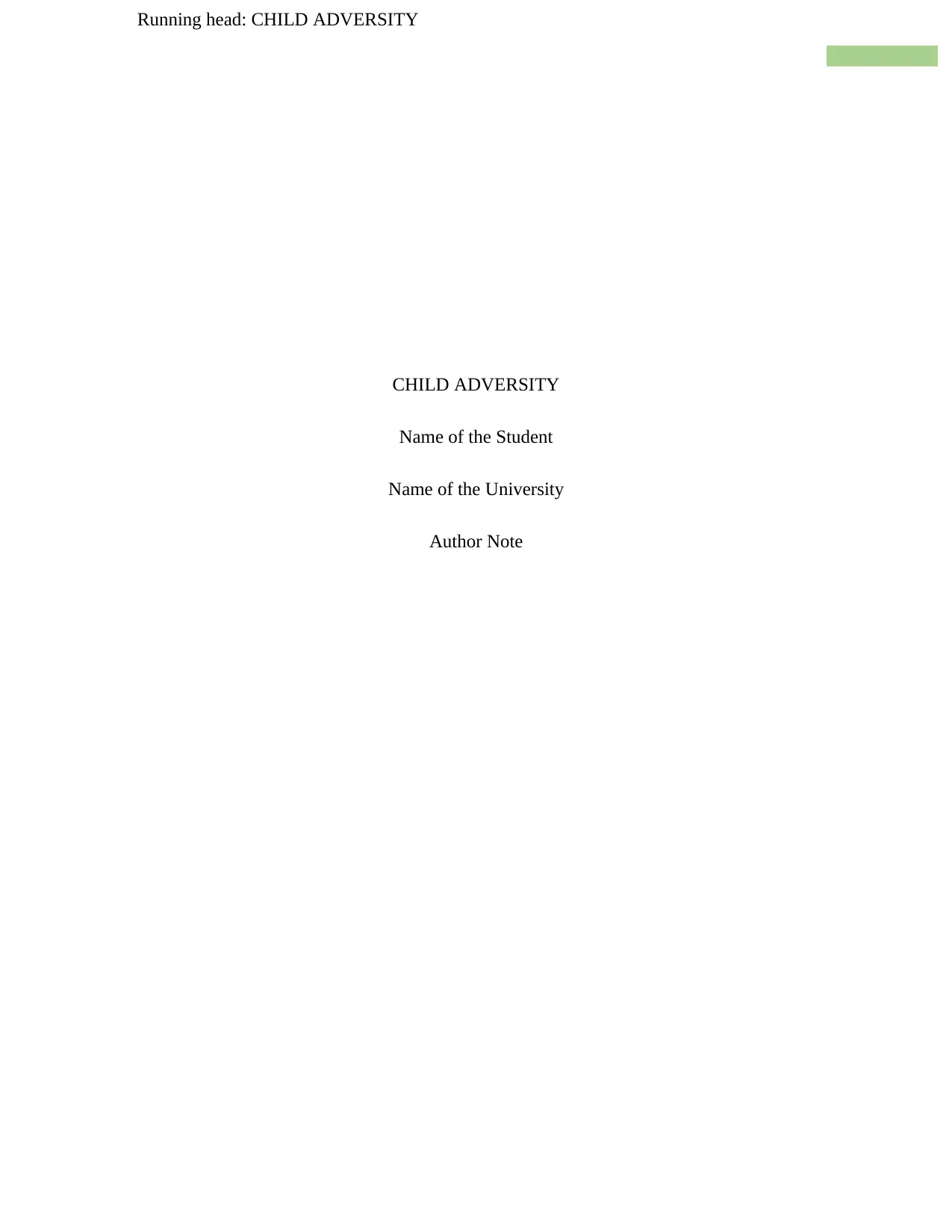
Running head: CHILD ADVERSITY
CHILD ADVERSITY
Name of the Student
Name of the University
Author Note
CHILD ADVERSITY
Name of the Student
Name of the University
Author Note
Secure Best Marks with AI Grader
Need help grading? Try our AI Grader for instant feedback on your assignments.
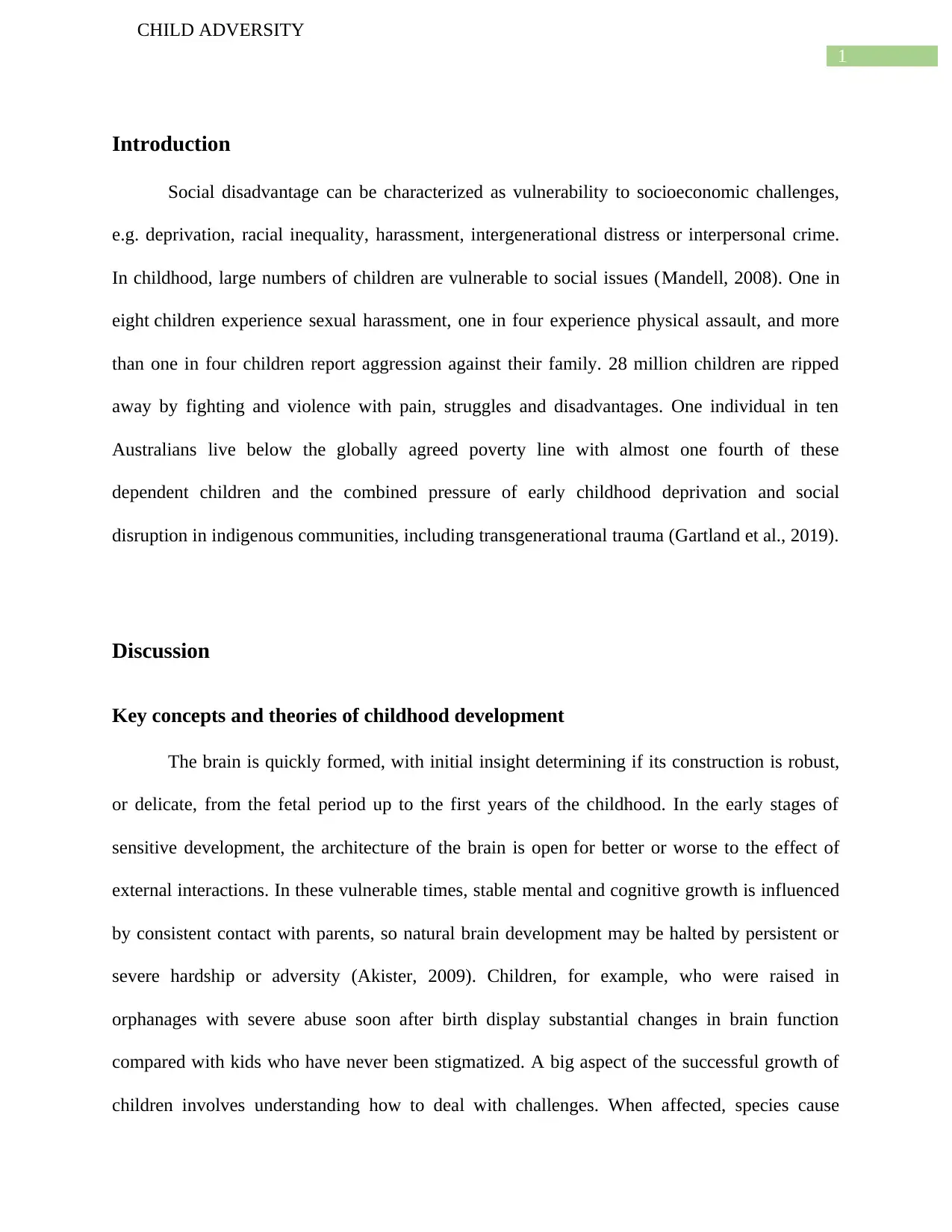
1
CHILD ADVERSITY
Introduction
Social disadvantage can be characterized as vulnerability to socioeconomic challenges,
e.g. deprivation, racial inequality, harassment, intergenerational distress or interpersonal crime.
In childhood, large numbers of children are vulnerable to social issues (Mandell, 2008). One in
eight children experience sexual harassment, one in four experience physical assault, and more
than one in four children report aggression against their family. 28 million children are ripped
away by fighting and violence with pain, struggles and disadvantages. One individual in ten
Australians live below the globally agreed poverty line with almost one fourth of these
dependent children and the combined pressure of early childhood deprivation and social
disruption in indigenous communities, including transgenerational trauma (Gartland et al., 2019).
Discussion
Key concepts and theories of childhood development
The brain is quickly formed, with initial insight determining if its construction is robust,
or delicate, from the fetal period up to the first years of the childhood. In the early stages of
sensitive development, the architecture of the brain is open for better or worse to the effect of
external interactions. In these vulnerable times, stable mental and cognitive growth is influenced
by consistent contact with parents, so natural brain development may be halted by persistent or
severe hardship or adversity (Akister, 2009). Children, for example, who were raised in
orphanages with severe abuse soon after birth display substantial changes in brain function
compared with kids who have never been stigmatized. A big aspect of the successful growth of
children involves understanding how to deal with challenges. When affected, species cause
CHILD ADVERSITY
Introduction
Social disadvantage can be characterized as vulnerability to socioeconomic challenges,
e.g. deprivation, racial inequality, harassment, intergenerational distress or interpersonal crime.
In childhood, large numbers of children are vulnerable to social issues (Mandell, 2008). One in
eight children experience sexual harassment, one in four experience physical assault, and more
than one in four children report aggression against their family. 28 million children are ripped
away by fighting and violence with pain, struggles and disadvantages. One individual in ten
Australians live below the globally agreed poverty line with almost one fourth of these
dependent children and the combined pressure of early childhood deprivation and social
disruption in indigenous communities, including transgenerational trauma (Gartland et al., 2019).
Discussion
Key concepts and theories of childhood development
The brain is quickly formed, with initial insight determining if its construction is robust,
or delicate, from the fetal period up to the first years of the childhood. In the early stages of
sensitive development, the architecture of the brain is open for better or worse to the effect of
external interactions. In these vulnerable times, stable mental and cognitive growth is influenced
by consistent contact with parents, so natural brain development may be halted by persistent or
severe hardship or adversity (Akister, 2009). Children, for example, who were raised in
orphanages with severe abuse soon after birth display substantial changes in brain function
compared with kids who have never been stigmatized. A big aspect of the successful growth of
children involves understanding how to deal with challenges. When affected, species cause
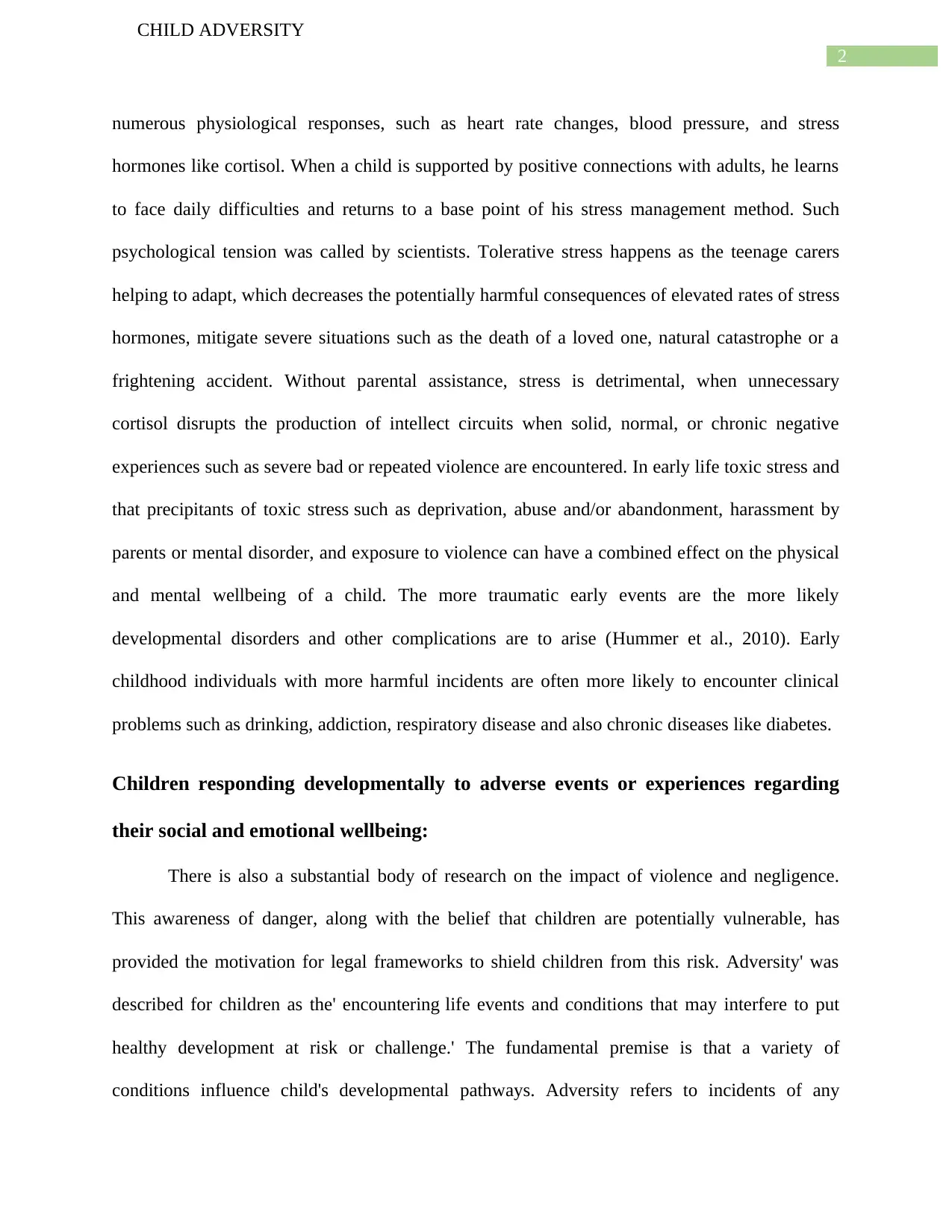
2
CHILD ADVERSITY
numerous physiological responses, such as heart rate changes, blood pressure, and stress
hormones like cortisol. When a child is supported by positive connections with adults, he learns
to face daily difficulties and returns to a base point of his stress management method. Such
psychological tension was called by scientists. Tolerative stress happens as the teenage carers
helping to adapt, which decreases the potentially harmful consequences of elevated rates of stress
hormones, mitigate severe situations such as the death of a loved one, natural catastrophe or a
frightening accident. Without parental assistance, stress is detrimental, when unnecessary
cortisol disrupts the production of intellect circuits when solid, normal, or chronic negative
experiences such as severe bad or repeated violence are encountered. In early life toxic stress and
that precipitants of toxic stress such as deprivation, abuse and/or abandonment, harassment by
parents or mental disorder, and exposure to violence can have a combined effect on the physical
and mental wellbeing of a child. The more traumatic early events are the more likely
developmental disorders and other complications are to arise (Hummer et al., 2010). Early
childhood individuals with more harmful incidents are often more likely to encounter clinical
problems such as drinking, addiction, respiratory disease and also chronic diseases like diabetes.
Children responding developmentally to adverse events or experiences regarding
their social and emotional wellbeing:
There is also a substantial body of research on the impact of violence and negligence.
This awareness of danger, along with the belief that children are potentially vulnerable, has
provided the motivation for legal frameworks to shield children from this risk. Adversity' was
described for children as the' encountering life events and conditions that may interfere to put
healthy development at risk or challenge.' The fundamental premise is that a variety of
conditions influence child's developmental pathways. Adversity refers to incidents of any
CHILD ADVERSITY
numerous physiological responses, such as heart rate changes, blood pressure, and stress
hormones like cortisol. When a child is supported by positive connections with adults, he learns
to face daily difficulties and returns to a base point of his stress management method. Such
psychological tension was called by scientists. Tolerative stress happens as the teenage carers
helping to adapt, which decreases the potentially harmful consequences of elevated rates of stress
hormones, mitigate severe situations such as the death of a loved one, natural catastrophe or a
frightening accident. Without parental assistance, stress is detrimental, when unnecessary
cortisol disrupts the production of intellect circuits when solid, normal, or chronic negative
experiences such as severe bad or repeated violence are encountered. In early life toxic stress and
that precipitants of toxic stress such as deprivation, abuse and/or abandonment, harassment by
parents or mental disorder, and exposure to violence can have a combined effect on the physical
and mental wellbeing of a child. The more traumatic early events are the more likely
developmental disorders and other complications are to arise (Hummer et al., 2010). Early
childhood individuals with more harmful incidents are often more likely to encounter clinical
problems such as drinking, addiction, respiratory disease and also chronic diseases like diabetes.
Children responding developmentally to adverse events or experiences regarding
their social and emotional wellbeing:
There is also a substantial body of research on the impact of violence and negligence.
This awareness of danger, along with the belief that children are potentially vulnerable, has
provided the motivation for legal frameworks to shield children from this risk. Adversity' was
described for children as the' encountering life events and conditions that may interfere to put
healthy development at risk or challenge.' The fundamental premise is that a variety of
conditions influence child's developmental pathways. Adversity refers to incidents of any
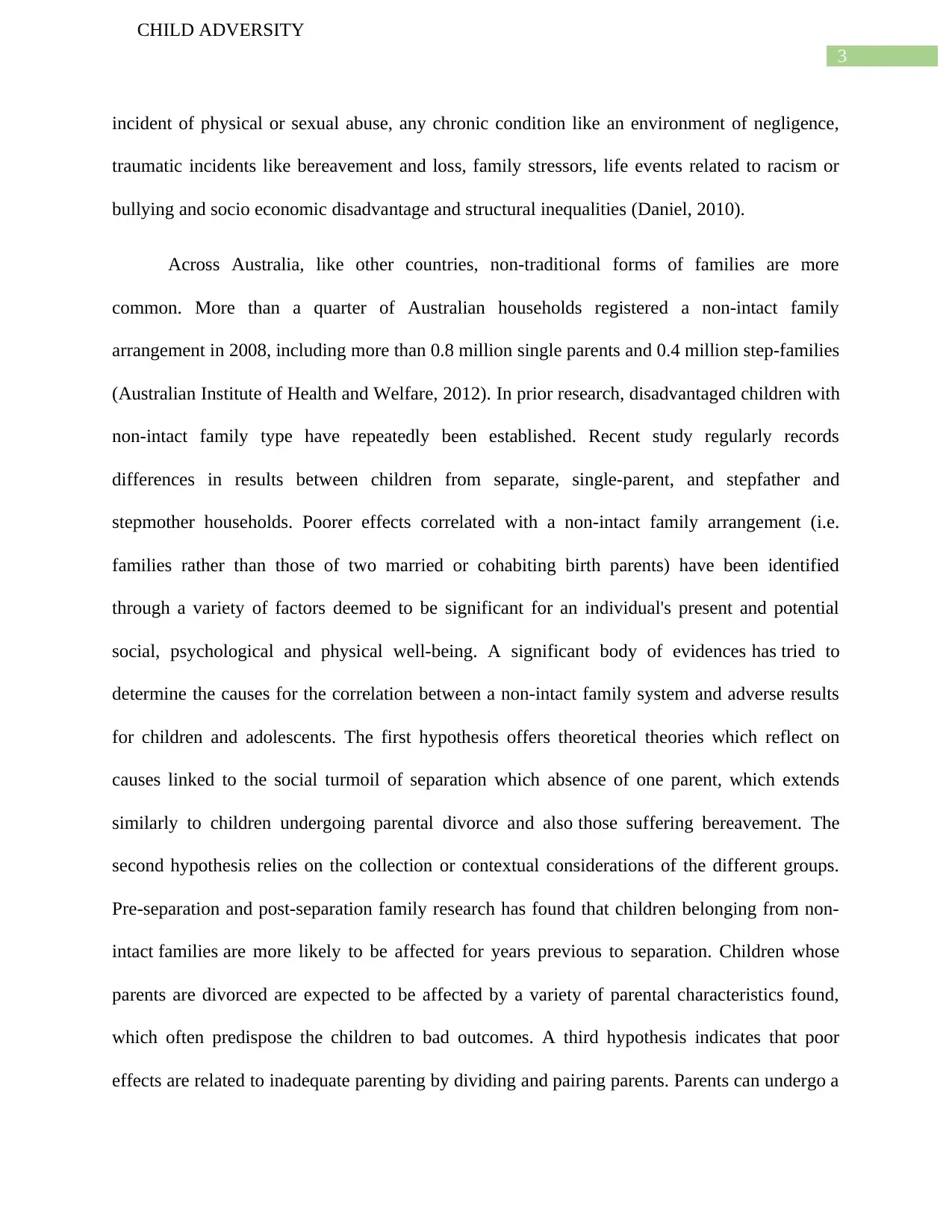
3
CHILD ADVERSITY
incident of physical or sexual abuse, any chronic condition like an environment of negligence,
traumatic incidents like bereavement and loss, family stressors, life events related to racism or
bullying and socio economic disadvantage and structural inequalities (Daniel, 2010).
Across Australia, like other countries, non-traditional forms of families are more
common. More than a quarter of Australian households registered a non-intact family
arrangement in 2008, including more than 0.8 million single parents and 0.4 million step-families
(Australian Institute of Health and Welfare, 2012). In prior research, disadvantaged children with
non-intact family type have repeatedly been established. Recent study regularly records
differences in results between children from separate, single-parent, and stepfather and
stepmother households. Poorer effects correlated with a non-intact family arrangement (i.e.
families rather than those of two married or cohabiting birth parents) have been identified
through a variety of factors deemed to be significant for an individual's present and potential
social, psychological and physical well-being. A significant body of evidences has tried to
determine the causes for the correlation between a non-intact family system and adverse results
for children and adolescents. The first hypothesis offers theoretical theories which reflect on
causes linked to the social turmoil of separation which absence of one parent, which extends
similarly to children undergoing parental divorce and also those suffering bereavement. The
second hypothesis relies on the collection or contextual considerations of the different groups.
Pre-separation and post-separation family research has found that children belonging from non-
intact families are more likely to be affected for years previous to separation. Children whose
parents are divorced are expected to be affected by a variety of parental characteristics found,
which often predispose the children to bad outcomes. A third hypothesis indicates that poor
effects are related to inadequate parenting by dividing and pairing parents. Parents can undergo a
CHILD ADVERSITY
incident of physical or sexual abuse, any chronic condition like an environment of negligence,
traumatic incidents like bereavement and loss, family stressors, life events related to racism or
bullying and socio economic disadvantage and structural inequalities (Daniel, 2010).
Across Australia, like other countries, non-traditional forms of families are more
common. More than a quarter of Australian households registered a non-intact family
arrangement in 2008, including more than 0.8 million single parents and 0.4 million step-families
(Australian Institute of Health and Welfare, 2012). In prior research, disadvantaged children with
non-intact family type have repeatedly been established. Recent study regularly records
differences in results between children from separate, single-parent, and stepfather and
stepmother households. Poorer effects correlated with a non-intact family arrangement (i.e.
families rather than those of two married or cohabiting birth parents) have been identified
through a variety of factors deemed to be significant for an individual's present and potential
social, psychological and physical well-being. A significant body of evidences has tried to
determine the causes for the correlation between a non-intact family system and adverse results
for children and adolescents. The first hypothesis offers theoretical theories which reflect on
causes linked to the social turmoil of separation which absence of one parent, which extends
similarly to children undergoing parental divorce and also those suffering bereavement. The
second hypothesis relies on the collection or contextual considerations of the different groups.
Pre-separation and post-separation family research has found that children belonging from non-
intact families are more likely to be affected for years previous to separation. Children whose
parents are divorced are expected to be affected by a variety of parental characteristics found,
which often predispose the children to bad outcomes. A third hypothesis indicates that poor
effects are related to inadequate parenting by dividing and pairing parents. Parents can undergo a
Secure Best Marks with AI Grader
Need help grading? Try our AI Grader for instant feedback on your assignments.
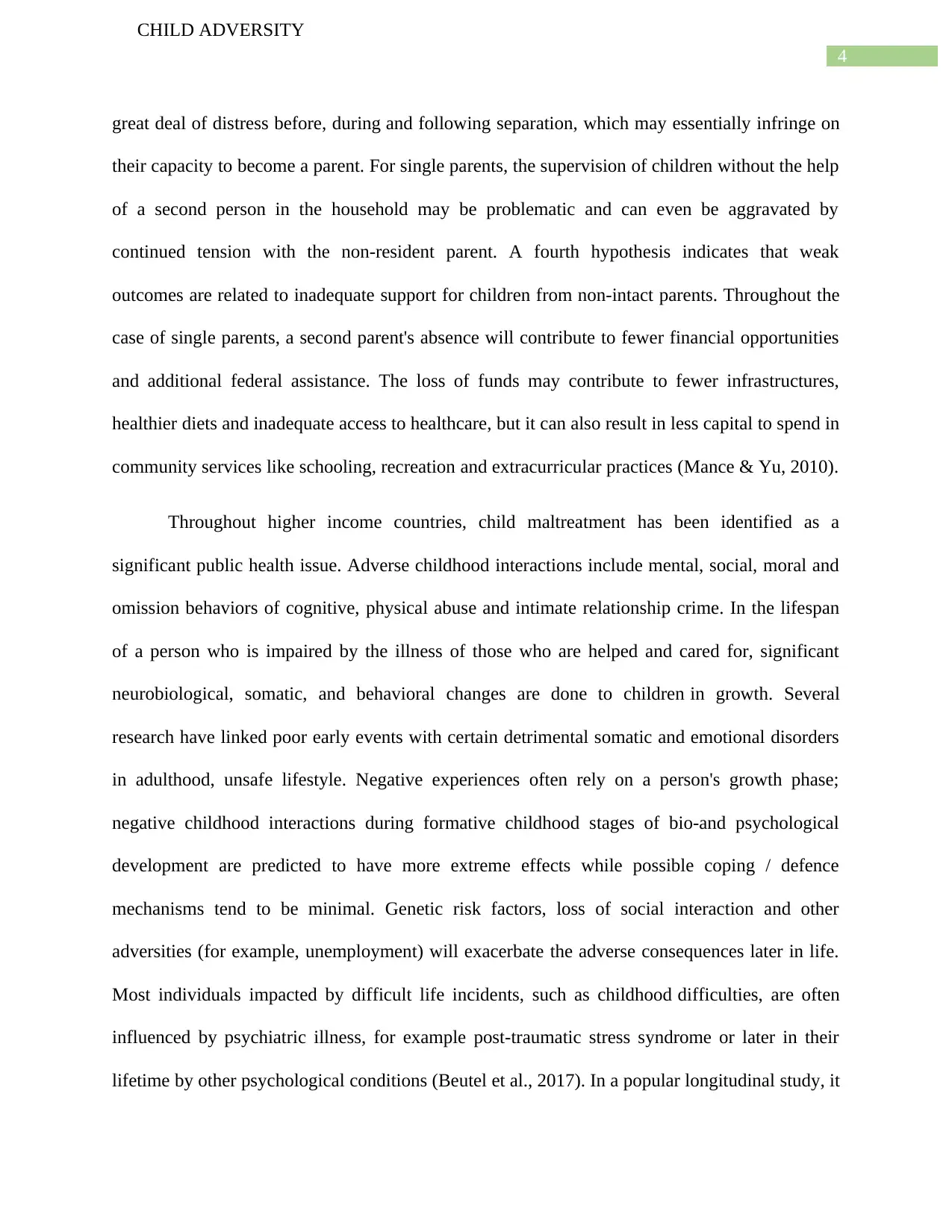
4
CHILD ADVERSITY
great deal of distress before, during and following separation, which may essentially infringe on
their capacity to become a parent. For single parents, the supervision of children without the help
of a second person in the household may be problematic and can even be aggravated by
continued tension with the non-resident parent. A fourth hypothesis indicates that weak
outcomes are related to inadequate support for children from non-intact parents. Throughout the
case of single parents, a second parent's absence will contribute to fewer financial opportunities
and additional federal assistance. The loss of funds may contribute to fewer infrastructures,
healthier diets and inadequate access to healthcare, but it can also result in less capital to spend in
community services like schooling, recreation and extracurricular practices (Mance & Yu, 2010).
Throughout higher income countries, child maltreatment has been identified as a
significant public health issue. Adverse childhood interactions include mental, social, moral and
omission behaviors of cognitive, physical abuse and intimate relationship crime. In the lifespan
of a person who is impaired by the illness of those who are helped and cared for, significant
neurobiological, somatic, and behavioral changes are done to children in growth. Several
research have linked poor early events with certain detrimental somatic and emotional disorders
in adulthood, unsafe lifestyle. Negative experiences often rely on a person's growth phase;
negative childhood interactions during formative childhood stages of bio-and psychological
development are predicted to have more extreme effects while possible coping / defence
mechanisms tend to be minimal. Genetic risk factors, loss of social interaction and other
adversities (for example, unemployment) will exacerbate the adverse consequences later in life.
Most individuals impacted by difficult life incidents, such as childhood difficulties, are often
influenced by psychiatric illness, for example post-traumatic stress syndrome or later in their
lifetime by other psychological conditions (Beutel et al., 2017). In a popular longitudinal study, it
CHILD ADVERSITY
great deal of distress before, during and following separation, which may essentially infringe on
their capacity to become a parent. For single parents, the supervision of children without the help
of a second person in the household may be problematic and can even be aggravated by
continued tension with the non-resident parent. A fourth hypothesis indicates that weak
outcomes are related to inadequate support for children from non-intact parents. Throughout the
case of single parents, a second parent's absence will contribute to fewer financial opportunities
and additional federal assistance. The loss of funds may contribute to fewer infrastructures,
healthier diets and inadequate access to healthcare, but it can also result in less capital to spend in
community services like schooling, recreation and extracurricular practices (Mance & Yu, 2010).
Throughout higher income countries, child maltreatment has been identified as a
significant public health issue. Adverse childhood interactions include mental, social, moral and
omission behaviors of cognitive, physical abuse and intimate relationship crime. In the lifespan
of a person who is impaired by the illness of those who are helped and cared for, significant
neurobiological, somatic, and behavioral changes are done to children in growth. Several
research have linked poor early events with certain detrimental somatic and emotional disorders
in adulthood, unsafe lifestyle. Negative experiences often rely on a person's growth phase;
negative childhood interactions during formative childhood stages of bio-and psychological
development are predicted to have more extreme effects while possible coping / defence
mechanisms tend to be minimal. Genetic risk factors, loss of social interaction and other
adversities (for example, unemployment) will exacerbate the adverse consequences later in life.
Most individuals impacted by difficult life incidents, such as childhood difficulties, are often
influenced by psychiatric illness, for example post-traumatic stress syndrome or later in their
lifetime by other psychological conditions (Beutel et al., 2017). In a popular longitudinal study, it

5
CHILD ADVERSITY
is shown that around a third of them were born under high-risk circumstances such as
deprivation, parental divorce and mental disability after creation of almost 700 subjects in
Hawaii's Kauai Island. Yet 72 of these high-risk children are alluded to as "resilient" to such risk
factors as capable and well-adapted adults (Werner, 1992).
Impact of cultural identity, gender, disability, loss and grief, trauma,
displacement/dispossession or social isolation on adversity and the social and
emotional well-being of children
Intimacy and association are fundamental desires of humanity. Interpersonal connections
provide several advantages; they provide a reference structure for social identities, and provide
comfort and relaxation in difficult times. Relationships in childhood will be particularly critical,
as personality forms and mental and behavioral issues take form during their lives. The absence
or loss of these relationships will harm the well-being of individuals in the sense provided
that positive social relationships are worthwhile and desirable. In fact, children with behavioral
or emotional disorders can encounter integration problems in social environments (Matthews et
al., 2015).
The mental, behavioral, cognitive, social and physical function of children is profoundly
impaired by childhood trauma. The organizational and functional status of the evolved brain is
determined by development experience. In the context of the fundamental concepts of
neurodevelopment, the effect of traumatic events on brain development and function is
discussed. Different physical and behavioral reactions to trauma are adaptive, including
hyperarousal and neural dissociation. The more a child is in a hyperarousal or dissociation, the
more probable the developing brain is to learn and internalize new data in a use-dependent
manner, the more likely the trauma may lead to neuropsychiatric symptoms. If they continue, the
CHILD ADVERSITY
is shown that around a third of them were born under high-risk circumstances such as
deprivation, parental divorce and mental disability after creation of almost 700 subjects in
Hawaii's Kauai Island. Yet 72 of these high-risk children are alluded to as "resilient" to such risk
factors as capable and well-adapted adults (Werner, 1992).
Impact of cultural identity, gender, disability, loss and grief, trauma,
displacement/dispossession or social isolation on adversity and the social and
emotional well-being of children
Intimacy and association are fundamental desires of humanity. Interpersonal connections
provide several advantages; they provide a reference structure for social identities, and provide
comfort and relaxation in difficult times. Relationships in childhood will be particularly critical,
as personality forms and mental and behavioral issues take form during their lives. The absence
or loss of these relationships will harm the well-being of individuals in the sense provided
that positive social relationships are worthwhile and desirable. In fact, children with behavioral
or emotional disorders can encounter integration problems in social environments (Matthews et
al., 2015).
The mental, behavioral, cognitive, social and physical function of children is profoundly
impaired by childhood trauma. The organizational and functional status of the evolved brain is
determined by development experience. In the context of the fundamental concepts of
neurodevelopment, the effect of traumatic events on brain development and function is
discussed. Different physical and behavioral reactions to trauma are adaptive, including
hyperarousal and neural dissociation. The more a child is in a hyperarousal or dissociation, the
more probable the developing brain is to learn and internalize new data in a use-dependent
manner, the more likely the trauma may lead to neuropsychiatric symptoms. If they continue, the
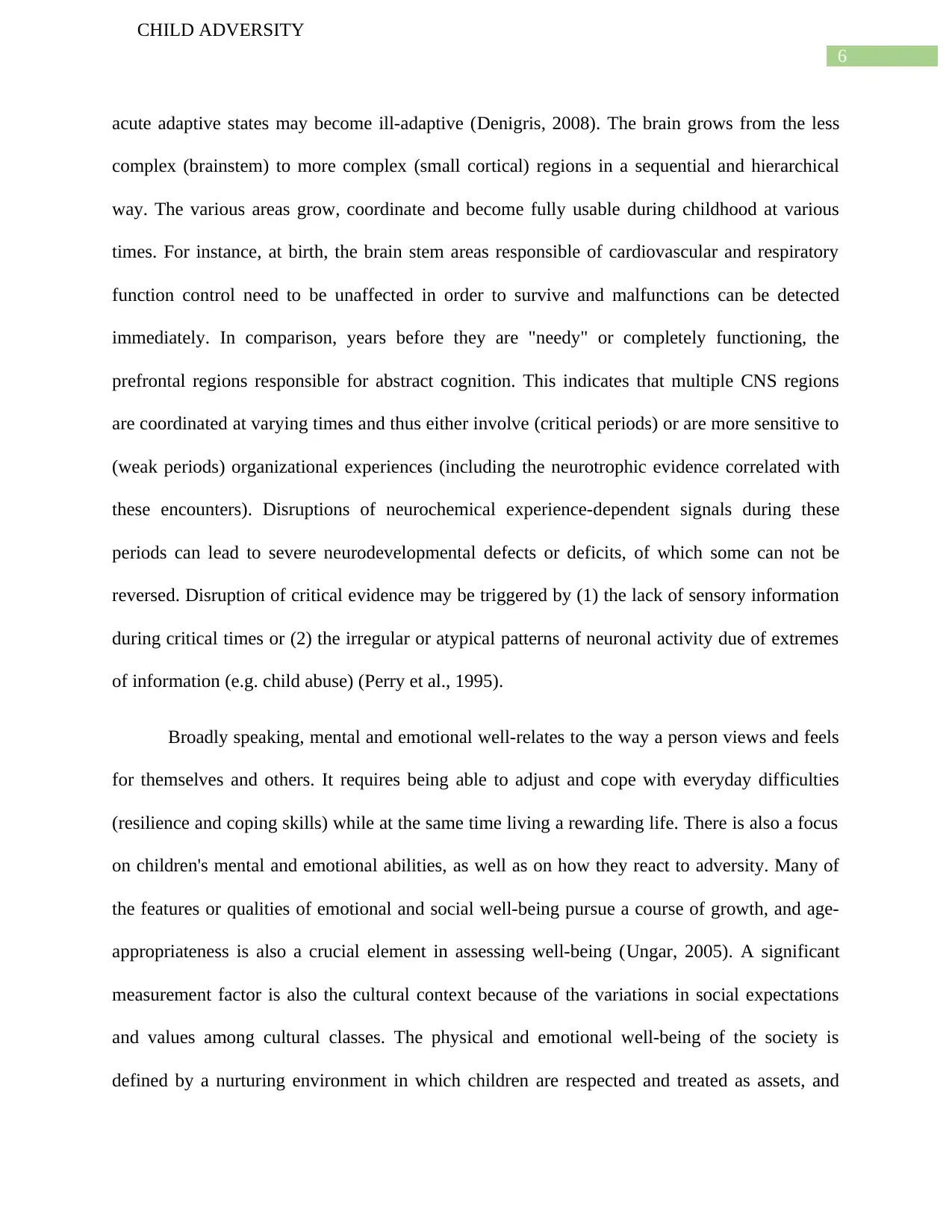
6
CHILD ADVERSITY
acute adaptive states may become ill-adaptive (Denigris, 2008). The brain grows from the less
complex (brainstem) to more complex (small cortical) regions in a sequential and hierarchical
way. The various areas grow, coordinate and become fully usable during childhood at various
times. For instance, at birth, the brain stem areas responsible of cardiovascular and respiratory
function control need to be unaffected in order to survive and malfunctions can be detected
immediately. In comparison, years before they are "needy" or completely functioning, the
prefrontal regions responsible for abstract cognition. This indicates that multiple CNS regions
are coordinated at varying times and thus either involve (critical periods) or are more sensitive to
(weak periods) organizational experiences (including the neurotrophic evidence correlated with
these encounters). Disruptions of neurochemical experience-dependent signals during these
periods can lead to severe neurodevelopmental defects or deficits, of which some can not be
reversed. Disruption of critical evidence may be triggered by (1) the lack of sensory information
during critical times or (2) the irregular or atypical patterns of neuronal activity due of extremes
of information (e.g. child abuse) (Perry et al., 1995).
Broadly speaking, mental and emotional well-relates to the way a person views and feels
for themselves and others. It requires being able to adjust and cope with everyday difficulties
(resilience and coping skills) while at the same time living a rewarding life. There is also a focus
on children's mental and emotional abilities, as well as on how they react to adversity. Many of
the features or qualities of emotional and social well-being pursue a course of growth, and age-
appropriateness is also a crucial element in assessing well-being (Ungar, 2005). A significant
measurement factor is also the cultural context because of the variations in social expectations
and values among cultural classes. The physical and emotional well-being of the society is
defined by a nurturing environment in which children are respected and treated as assets, and
CHILD ADVERSITY
acute adaptive states may become ill-adaptive (Denigris, 2008). The brain grows from the less
complex (brainstem) to more complex (small cortical) regions in a sequential and hierarchical
way. The various areas grow, coordinate and become fully usable during childhood at various
times. For instance, at birth, the brain stem areas responsible of cardiovascular and respiratory
function control need to be unaffected in order to survive and malfunctions can be detected
immediately. In comparison, years before they are "needy" or completely functioning, the
prefrontal regions responsible for abstract cognition. This indicates that multiple CNS regions
are coordinated at varying times and thus either involve (critical periods) or are more sensitive to
(weak periods) organizational experiences (including the neurotrophic evidence correlated with
these encounters). Disruptions of neurochemical experience-dependent signals during these
periods can lead to severe neurodevelopmental defects or deficits, of which some can not be
reversed. Disruption of critical evidence may be triggered by (1) the lack of sensory information
during critical times or (2) the irregular or atypical patterns of neuronal activity due of extremes
of information (e.g. child abuse) (Perry et al., 1995).
Broadly speaking, mental and emotional well-relates to the way a person views and feels
for themselves and others. It requires being able to adjust and cope with everyday difficulties
(resilience and coping skills) while at the same time living a rewarding life. There is also a focus
on children's mental and emotional abilities, as well as on how they react to adversity. Many of
the features or qualities of emotional and social well-being pursue a course of growth, and age-
appropriateness is also a crucial element in assessing well-being (Ungar, 2005). A significant
measurement factor is also the cultural context because of the variations in social expectations
and values among cultural classes. The physical and emotional well-being of the society is
defined by a nurturing environment in which children are respected and treated as assets, and
Paraphrase This Document
Need a fresh take? Get an instant paraphrase of this document with our AI Paraphraser
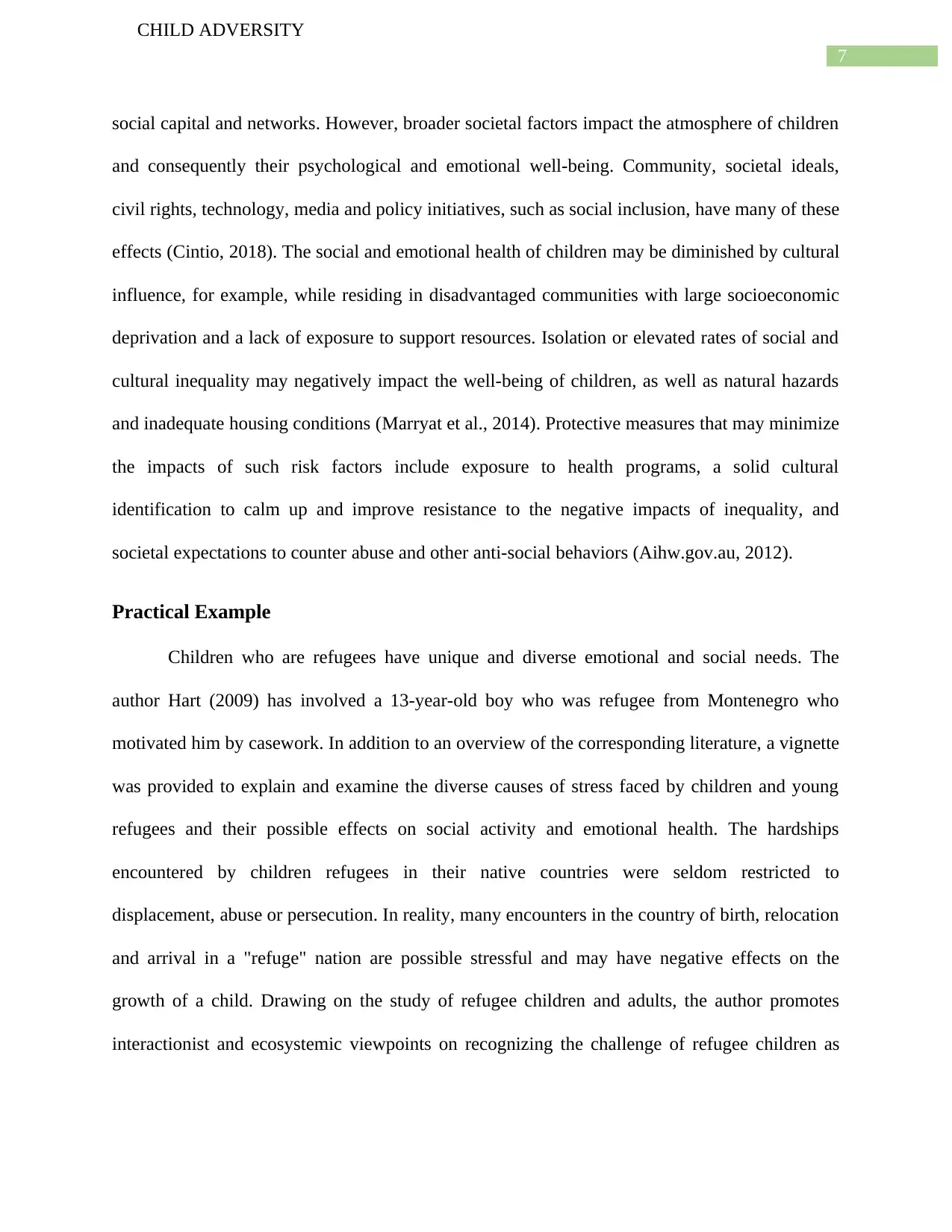
7
CHILD ADVERSITY
social capital and networks. However, broader societal factors impact the atmosphere of children
and consequently their psychological and emotional well-being. Community, societal ideals,
civil rights, technology, media and policy initiatives, such as social inclusion, have many of these
effects (Cintio, 2018). The social and emotional health of children may be diminished by cultural
influence, for example, while residing in disadvantaged communities with large socioeconomic
deprivation and a lack of exposure to support resources. Isolation or elevated rates of social and
cultural inequality may negatively impact the well-being of children, as well as natural hazards
and inadequate housing conditions (Marryat et al., 2014). Protective measures that may minimize
the impacts of such risk factors include exposure to health programs, a solid cultural
identification to calm up and improve resistance to the negative impacts of inequality, and
societal expectations to counter abuse and other anti-social behaviors (Aihw.gov.au, 2012).
Practical Example
Children who are refugees have unique and diverse emotional and social needs. The
author Hart (2009) has involved a 13-year-old boy who was refugee from Montenegro who
motivated him by casework. In addition to an overview of the corresponding literature, a vignette
was provided to explain and examine the diverse causes of stress faced by children and young
refugees and their possible effects on social activity and emotional health. The hardships
encountered by children refugees in their native countries were seldom restricted to
displacement, abuse or persecution. In reality, many encounters in the country of birth, relocation
and arrival in a "refuge" nation are possible stressful and may have negative effects on the
growth of a child. Drawing on the study of refugee children and adults, the author promotes
interactionist and ecosystemic viewpoints on recognizing the challenge of refugee children as
CHILD ADVERSITY
social capital and networks. However, broader societal factors impact the atmosphere of children
and consequently their psychological and emotional well-being. Community, societal ideals,
civil rights, technology, media and policy initiatives, such as social inclusion, have many of these
effects (Cintio, 2018). The social and emotional health of children may be diminished by cultural
influence, for example, while residing in disadvantaged communities with large socioeconomic
deprivation and a lack of exposure to support resources. Isolation or elevated rates of social and
cultural inequality may negatively impact the well-being of children, as well as natural hazards
and inadequate housing conditions (Marryat et al., 2014). Protective measures that may minimize
the impacts of such risk factors include exposure to health programs, a solid cultural
identification to calm up and improve resistance to the negative impacts of inequality, and
societal expectations to counter abuse and other anti-social behaviors (Aihw.gov.au, 2012).
Practical Example
Children who are refugees have unique and diverse emotional and social needs. The
author Hart (2009) has involved a 13-year-old boy who was refugee from Montenegro who
motivated him by casework. In addition to an overview of the corresponding literature, a vignette
was provided to explain and examine the diverse causes of stress faced by children and young
refugees and their possible effects on social activity and emotional health. The hardships
encountered by children refugees in their native countries were seldom restricted to
displacement, abuse or persecution. In reality, many encounters in the country of birth, relocation
and arrival in a "refuge" nation are possible stressful and may have negative effects on the
growth of a child. Drawing on the study of refugee children and adults, the author promotes
interactionist and ecosystemic viewpoints on recognizing the challenge of refugee children as
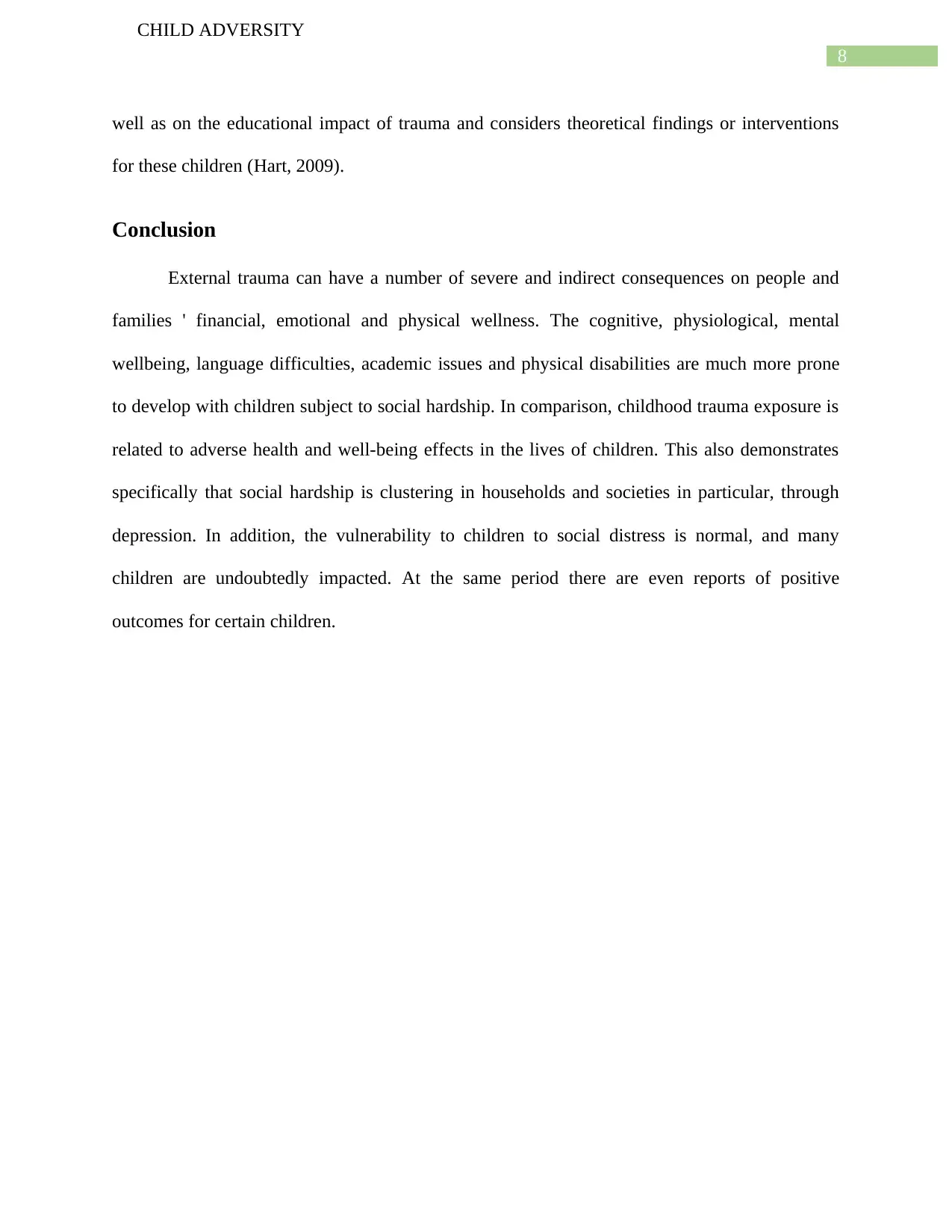
8
CHILD ADVERSITY
well as on the educational impact of trauma and considers theoretical findings or interventions
for these children (Hart, 2009).
Conclusion
External trauma can have a number of severe and indirect consequences on people and
families ' financial, emotional and physical wellness. The cognitive, physiological, mental
wellbeing, language difficulties, academic issues and physical disabilities are much more prone
to develop with children subject to social hardship. In comparison, childhood trauma exposure is
related to adverse health and well-being effects in the lives of children. This also demonstrates
specifically that social hardship is clustering in households and societies in particular, through
depression. In addition, the vulnerability to children to social distress is normal, and many
children are undoubtedly impacted. At the same period there are even reports of positive
outcomes for certain children.
CHILD ADVERSITY
well as on the educational impact of trauma and considers theoretical findings or interventions
for these children (Hart, 2009).
Conclusion
External trauma can have a number of severe and indirect consequences on people and
families ' financial, emotional and physical wellness. The cognitive, physiological, mental
wellbeing, language difficulties, academic issues and physical disabilities are much more prone
to develop with children subject to social hardship. In comparison, childhood trauma exposure is
related to adverse health and well-being effects in the lives of children. This also demonstrates
specifically that social hardship is clustering in households and societies in particular, through
depression. In addition, the vulnerability to children to social distress is normal, and many
children are undoubtedly impacted. At the same period there are even reports of positive
outcomes for certain children.
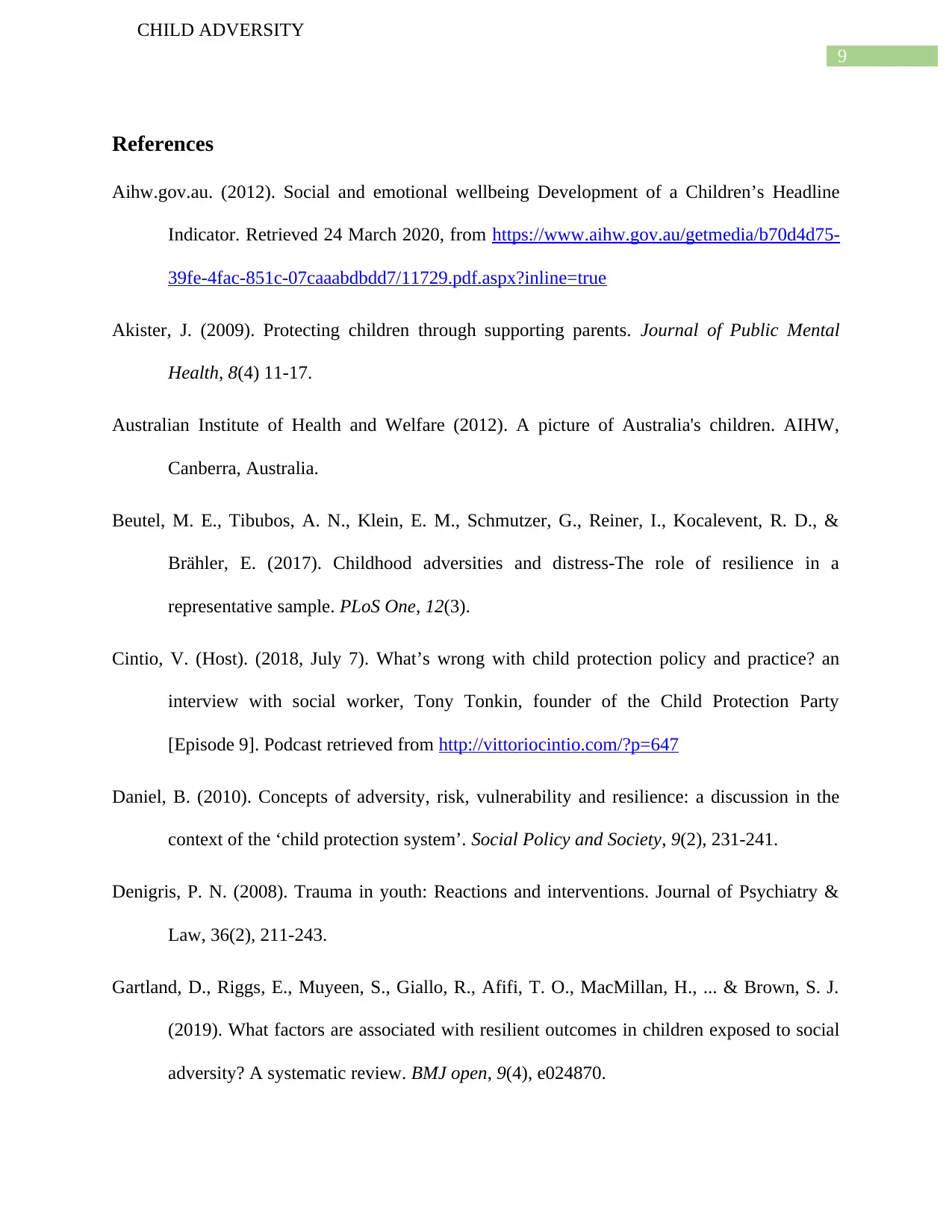
9
CHILD ADVERSITY
References
Aihw.gov.au. (2012). Social and emotional wellbeing Development of a Children’s Headline
Indicator. Retrieved 24 March 2020, from https://www.aihw.gov.au/getmedia/b70d4d75-
39fe-4fac-851c-07caaabdbdd7/11729.pdf.aspx?inline=true
Akister, J. (2009). Protecting children through supporting parents. Journal of Public Mental
Health, 8(4) 11-17.
Australian Institute of Health and Welfare (2012). A picture of Australia's children. AIHW,
Canberra, Australia.
Beutel, M. E., Tibubos, A. N., Klein, E. M., Schmutzer, G., Reiner, I., Kocalevent, R. D., &
Brähler, E. (2017). Childhood adversities and distress-The role of resilience in a
representative sample. PLoS One, 12(3).
Cintio, V. (Host). (2018, July 7). What’s wrong with child protection policy and practice? an
interview with social worker, Tony Tonkin, founder of the Child Protection Party
[Episode 9]. Podcast retrieved from http://vittoriocintio.com/?p=647
Daniel, B. (2010). Concepts of adversity, risk, vulnerability and resilience: a discussion in the
context of the ‘child protection system’. Social Policy and Society, 9(2), 231-241.
Denigris, P. N. (2008). Trauma in youth: Reactions and interventions. Journal of Psychiatry &
Law, 36(2), 211-243.
Gartland, D., Riggs, E., Muyeen, S., Giallo, R., Afifi, T. O., MacMillan, H., ... & Brown, S. J.
(2019). What factors are associated with resilient outcomes in children exposed to social
adversity? A systematic review. BMJ open, 9(4), e024870.
CHILD ADVERSITY
References
Aihw.gov.au. (2012). Social and emotional wellbeing Development of a Children’s Headline
Indicator. Retrieved 24 March 2020, from https://www.aihw.gov.au/getmedia/b70d4d75-
39fe-4fac-851c-07caaabdbdd7/11729.pdf.aspx?inline=true
Akister, J. (2009). Protecting children through supporting parents. Journal of Public Mental
Health, 8(4) 11-17.
Australian Institute of Health and Welfare (2012). A picture of Australia's children. AIHW,
Canberra, Australia.
Beutel, M. E., Tibubos, A. N., Klein, E. M., Schmutzer, G., Reiner, I., Kocalevent, R. D., &
Brähler, E. (2017). Childhood adversities and distress-The role of resilience in a
representative sample. PLoS One, 12(3).
Cintio, V. (Host). (2018, July 7). What’s wrong with child protection policy and practice? an
interview with social worker, Tony Tonkin, founder of the Child Protection Party
[Episode 9]. Podcast retrieved from http://vittoriocintio.com/?p=647
Daniel, B. (2010). Concepts of adversity, risk, vulnerability and resilience: a discussion in the
context of the ‘child protection system’. Social Policy and Society, 9(2), 231-241.
Denigris, P. N. (2008). Trauma in youth: Reactions and interventions. Journal of Psychiatry &
Law, 36(2), 211-243.
Gartland, D., Riggs, E., Muyeen, S., Giallo, R., Afifi, T. O., MacMillan, H., ... & Brown, S. J.
(2019). What factors are associated with resilient outcomes in children exposed to social
adversity? A systematic review. BMJ open, 9(4), e024870.
Secure Best Marks with AI Grader
Need help grading? Try our AI Grader for instant feedback on your assignments.
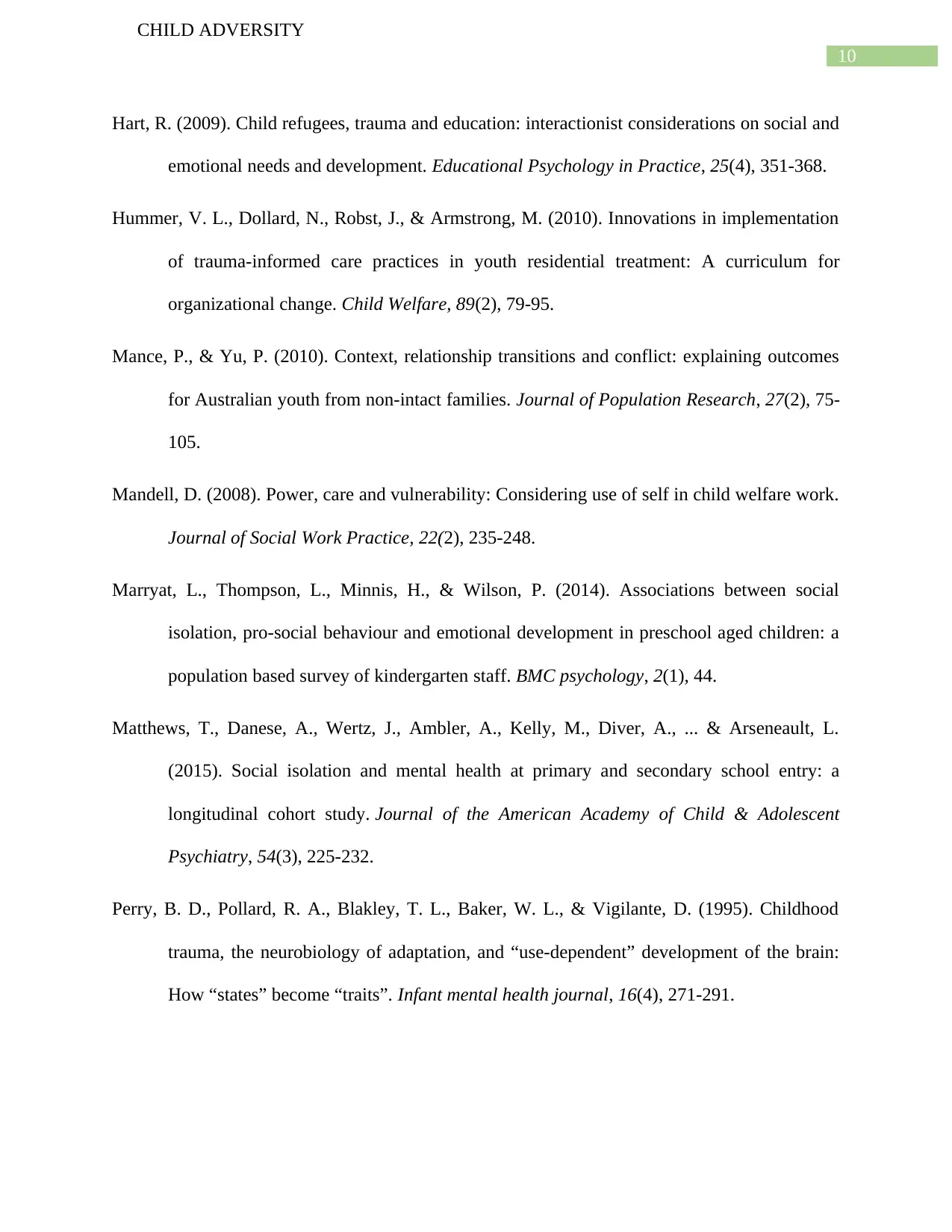
10
CHILD ADVERSITY
Hart, R. (2009). Child refugees, trauma and education: interactionist considerations on social and
emotional needs and development. Educational Psychology in Practice, 25(4), 351-368.
Hummer, V. L., Dollard, N., Robst, J., & Armstrong, M. (2010). Innovations in implementation
of trauma-informed care practices in youth residential treatment: A curriculum for
organizational change. Child Welfare, 89(2), 79-95.
Mance, P., & Yu, P. (2010). Context, relationship transitions and conflict: explaining outcomes
for Australian youth from non-intact families. Journal of Population Research, 27(2), 75-
105.
Mandell, D. (2008). Power, care and vulnerability: Considering use of self in child welfare work.
Journal of Social Work Practice, 22(2), 235-248.
Marryat, L., Thompson, L., Minnis, H., & Wilson, P. (2014). Associations between social
isolation, pro-social behaviour and emotional development in preschool aged children: a
population based survey of kindergarten staff. BMC psychology, 2(1), 44.
Matthews, T., Danese, A., Wertz, J., Ambler, A., Kelly, M., Diver, A., ... & Arseneault, L.
(2015). Social isolation and mental health at primary and secondary school entry: a
longitudinal cohort study. Journal of the American Academy of Child & Adolescent
Psychiatry, 54(3), 225-232.
Perry, B. D., Pollard, R. A., Blakley, T. L., Baker, W. L., & Vigilante, D. (1995). Childhood
trauma, the neurobiology of adaptation, and “use‐dependent” development of the brain:
How “states” become “traits”. Infant mental health journal, 16(4), 271-291.
CHILD ADVERSITY
Hart, R. (2009). Child refugees, trauma and education: interactionist considerations on social and
emotional needs and development. Educational Psychology in Practice, 25(4), 351-368.
Hummer, V. L., Dollard, N., Robst, J., & Armstrong, M. (2010). Innovations in implementation
of trauma-informed care practices in youth residential treatment: A curriculum for
organizational change. Child Welfare, 89(2), 79-95.
Mance, P., & Yu, P. (2010). Context, relationship transitions and conflict: explaining outcomes
for Australian youth from non-intact families. Journal of Population Research, 27(2), 75-
105.
Mandell, D. (2008). Power, care and vulnerability: Considering use of self in child welfare work.
Journal of Social Work Practice, 22(2), 235-248.
Marryat, L., Thompson, L., Minnis, H., & Wilson, P. (2014). Associations between social
isolation, pro-social behaviour and emotional development in preschool aged children: a
population based survey of kindergarten staff. BMC psychology, 2(1), 44.
Matthews, T., Danese, A., Wertz, J., Ambler, A., Kelly, M., Diver, A., ... & Arseneault, L.
(2015). Social isolation and mental health at primary and secondary school entry: a
longitudinal cohort study. Journal of the American Academy of Child & Adolescent
Psychiatry, 54(3), 225-232.
Perry, B. D., Pollard, R. A., Blakley, T. L., Baker, W. L., & Vigilante, D. (1995). Childhood
trauma, the neurobiology of adaptation, and “use‐dependent” development of the brain:
How “states” become “traits”. Infant mental health journal, 16(4), 271-291.
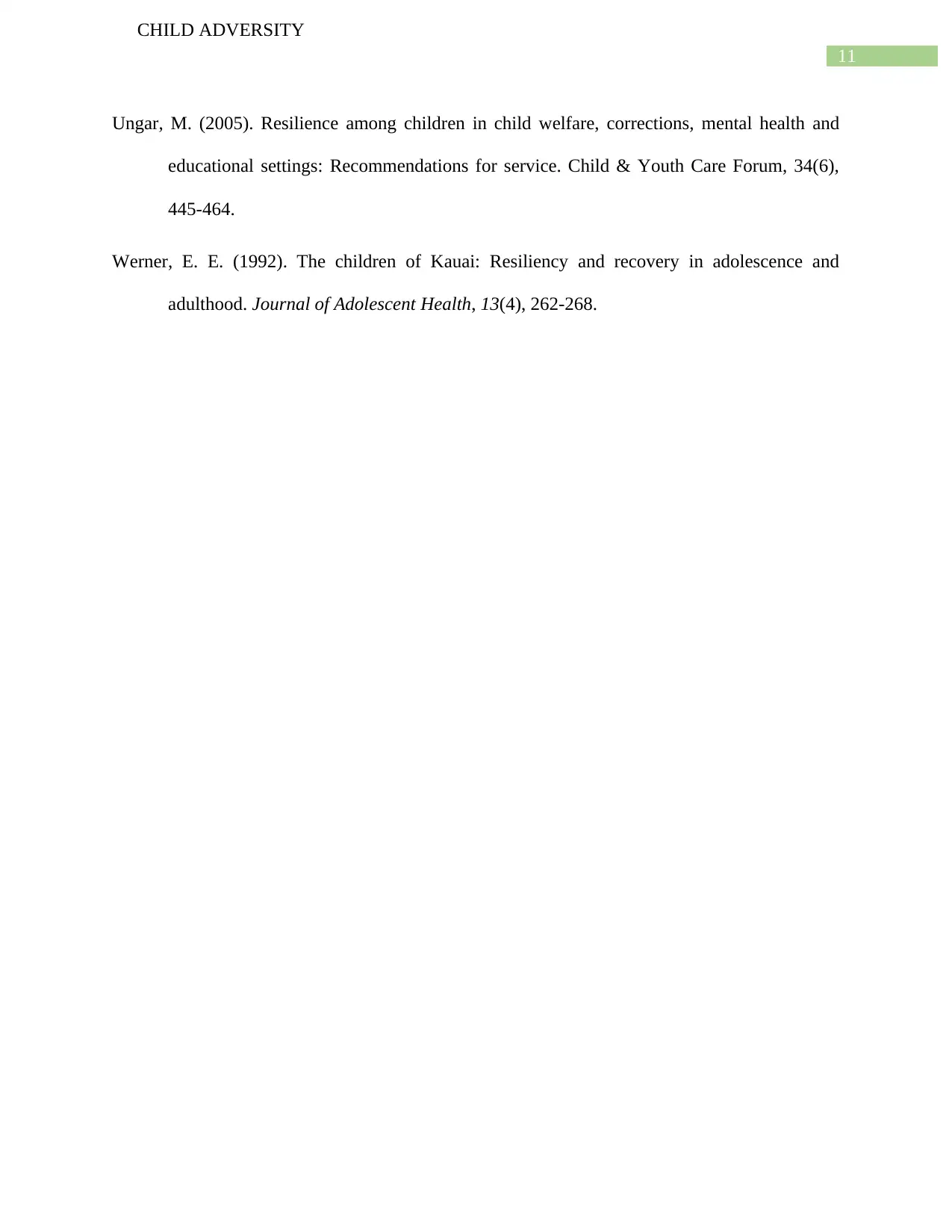
11
CHILD ADVERSITY
Ungar, M. (2005). Resilience among children in child welfare, corrections, mental health and
educational settings: Recommendations for service. Child & Youth Care Forum, 34(6),
445-464.
Werner, E. E. (1992). The children of Kauai: Resiliency and recovery in adolescence and
adulthood. Journal of Adolescent Health, 13(4), 262-268.
CHILD ADVERSITY
Ungar, M. (2005). Resilience among children in child welfare, corrections, mental health and
educational settings: Recommendations for service. Child & Youth Care Forum, 34(6),
445-464.
Werner, E. E. (1992). The children of Kauai: Resiliency and recovery in adolescence and
adulthood. Journal of Adolescent Health, 13(4), 262-268.
1 out of 12
Related Documents
Your All-in-One AI-Powered Toolkit for Academic Success.
+13062052269
info@desklib.com
Available 24*7 on WhatsApp / Email
![[object Object]](/_next/static/media/star-bottom.7253800d.svg)
Unlock your academic potential
© 2024 | Zucol Services PVT LTD | All rights reserved.





